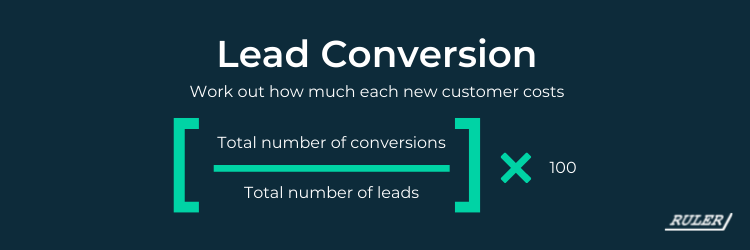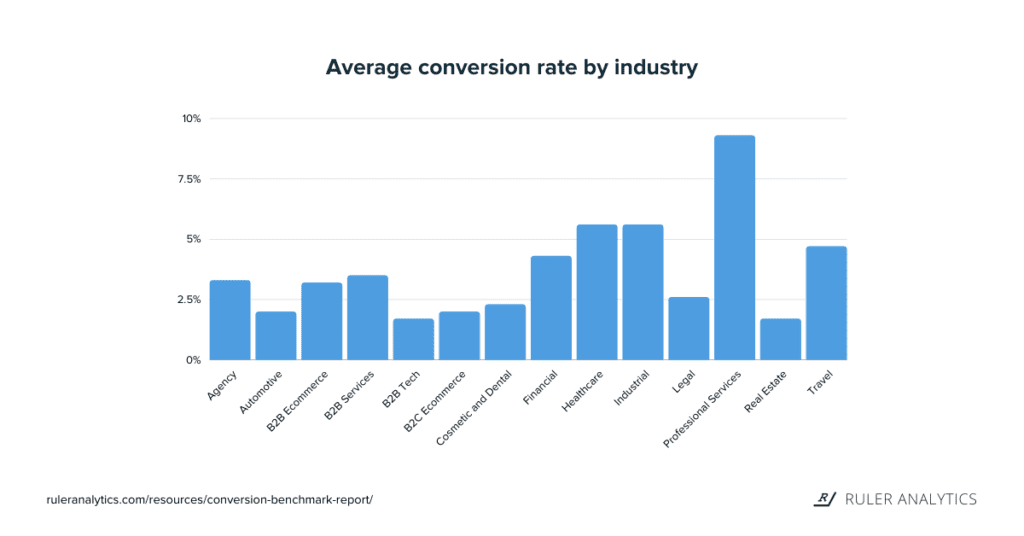Are you feeling the pressure to improve your lead conversion rate? With these lead conversion metrics, you’ll have a better view of your marketing impact.
So you’ve built your lead generation funnel and leads are ticking through.
People are visiting your site, converting into leads and entering your CRM. But what’s next?
Now you’re generating leads, the trick is to convert these leads into sales and customers. This process is lead conversion and is key for sales and marketing teams.
In this blog you’ll learn:
So, without further ado, let’s get stuck in.
✏️ Note
Learn even more about lead generation with our cheatsheet on lead tracking and lead nurturing.
Lead conversion is the process of converting leads into customers. It’s often a joint effort from sales and marketing and involves tactics like email nurturing, retargeting and discovery calls.
Unlike lead generation, where marketing teams convert website visitors into prospective customers, lead conversion is where leads are closed into a sale.
Given its position in the pipeline, lead conversion usually falls mostly to sales teams.
But, for the biggest impact, it’s better for sales and marketing to align and work together to improve their lead conversion rate.
Calculating your lead conversion rate is easy.
Just take the total number of conversions from a set period, divide it by your total number of leads and then multiply by 100.
The number you’re left with is your lead conversion rate.

In practice, the calculation of lead conversion rate looks like this.
In the month of May, Company A generated 150 leads, of which 35 went on to convert.
(35/150)*100 = 23.3% lead conversion rate
So now you know how to calculate your lead conversion rate, but what’s a good number to aim for?
Realistically, your lead conversion rate will depend on your industry, your product and more. But, you can benchmark yourself against others in your industry.
🚀 Pro Tip
Get the details on average conversion rate by industry and marketing source with our in-depth research and analysis
For a quick overview, here’s a look at the average conversion rates across 14 major industries.

Tracking your lead conversion rate is just one part of the picture when it comes to measuring your marketing performance.
By measuring your marketing against key lead conversion metrics, you can accurately understand what is and isn’t working.
Related: How to measure marketing with Ruler
The best lead conversion metrics are:
Let’s break them down one by one:
The first, of course, is lead conversion rate.
Monitoring the percentage of leads that are converting into opportunities is vital to understanding if you’re bringing in high-quality leads or not.
And, if your nurturing processes are working. With lead conversion rate by channel and campaign, you can better understand what’s working hardest to drive your bottom line.
💡 Pro Tip
Not sure how to connect your revenue, your leads and your marketing touchpoints? Read our blog on lead tracking to see how you can better link your data despite customer journey stages and long sales cycles.
Cost per lead, or CPL, is the amount of investment required to generate a new lead.
It’s a good metric to track to understand how your marketing budget is paying off.
But, cost per lead only takes you so far. A lead doesn’t guarantee revenue. So your investment for each lead might not actually ever result in closed revenue.
However, despite this, it’s still a great way to see how your lead generation funnel is working to create new leads.
Related: Tips from experts on generating leads for your business
Leading on from that, the next obvious lead conversion metric to measure is cost per acquisition. This is the cost it takes to gain a new customer.
Related: 5 ways to reduce cost per acquisition
Unlike cost per lead, it looks at the number of closed opportunities compared to the investment made.
It’s a much more robust metric that allows you to be hypercritical of your work. When viewed holistically, you can get a good sense of your return on investment.
And, when broken down by channel and campaign, you can see what’s performing best for your bottom line.
This metric, or ARPC, is a great way to understand what value each customer brings to your business.
Particularly important for SaaS businesses, this metric allows you to understand if you’re bringing in leads that go onto close into high-values sales.
If not, you can take steps to optimise your marketing to drive more high-value customers.
Related: SaaS metrics you need to start tracking and why
Are you looking at long sales cycles? Or, is there an opportunity present for you to speed up your time to conversion?
One key way to achieve this is by aligning your sales and marketing teams. By having your teams work together toward the same goal, they can optimise their parts of your pipeline to help you drive new leads and convert them quickly and effectively.
Related: Experts share their top tips to shorten the sales cycle
There are a few win rates that you can look at to determine how well your leads are converting into customers.
Firstly, win rates by opportunity or lead owner.
In your CRM, you can assess how well each team member is performing when it comes to converting leads into revenue.
By understanding this, you can identify who needs work and who is driving a high level of revenue.
Next is opportunity win rates by lead source. Say you invest in a paid campaign across social media which results in a high level of leads but very few closed sales. Then your opportunity win rate, compared to a more successful lead source, will be very low.
This is great insight for marketing who are looking to optimise their outputs. By altering efforts to hit your main KPIs, that’s revenue, you can ensure you stay on track to perform as best you can.
You could also look at your opportunity win rate by campaign too. This will allow you to understand which campaigns are bringing the most high-value leads to your business. Once you’ve got a formula that works, repeat it!
Lead conversion metrics are key for any sales and marketing team that is looking to better understand if the leads they’re driving are resulting in sales.
If you’re still optimising your content and campaigns based on vanity metrics like clicks, traffic and opens, then you need to re-evaluate your tracking and reporting.
With Ruler Analytics, you can link your lead data to your closed revenue with marketing attribution. Put simply, this allows you to connect closed sales back to the marketing touchpoints that influenced them.
Not sure how it works? Read our blog on optimising your marketing with Ruler Analytics to see the tangible results marketing attribution can bring to your marketing strategy.
Want to learn more about Ruler Analytics and how marketing attribution works in practice? Download our eBook on closed-loop marketing attribution and walk through each step.